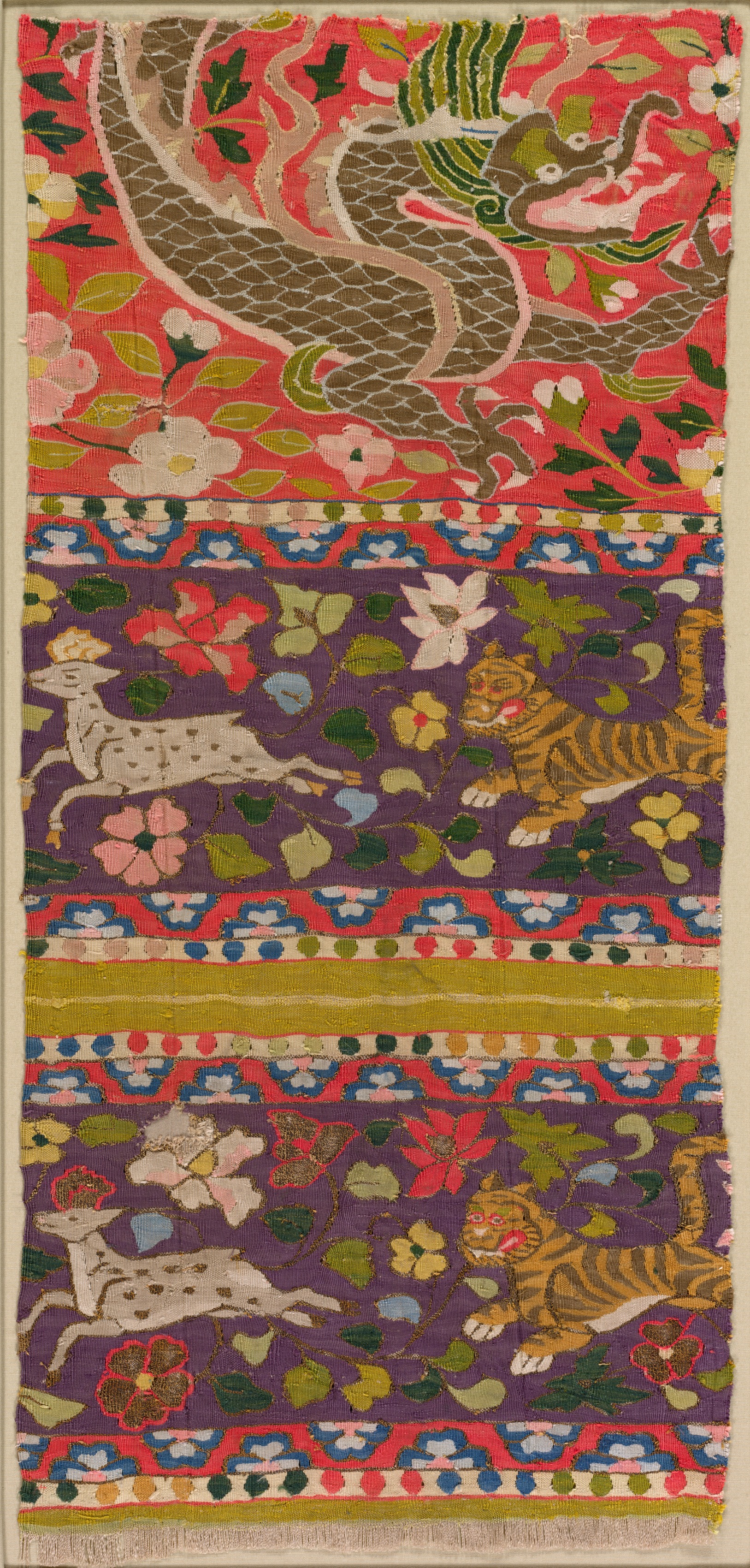The Cleveland Museum of Art
Collection Online as of April 25, 2024

Tigers Chasing Deer, with Dragon
1000s–1200
Overall: 58 x 27.2 cm (22 13/16 x 10 11/16 in.); Mounted: 75.6 x 43.8 cm (29 3/4 x 17 1/4 in.)
Leonard C. Hanna, Jr. Fund 1988.100
Location: not on view
Did You Know?
Two similar kesi in Cleveland’s collection include 1991.3 and 1988.33. All are roughly the same size and given their size all three rectangular fragments may have been used as sutra (prayer leaves) covers. All three have two vertical crease lines that divide the fragment roughly into thirds and differential fading between the central third and outer thirds, which further substantiates this possible usage.Description
This reversible tapestry (kesi) fragment woven with silk and metal thread is a section from yardage likely intended for a garment, but no contemporary paintings exist to confirm this. The starting, bottom edge of the textile is preserved which indicates the bands at the base would have been the cuff ends of a garment. The design motifs of this kesi—a dragon at the top, bands of pearls and split palmettes, and tigers chasing deer with mushroom-shaped antlers—are a synthesis of Western and Chinese elements. The pearls, palmettes, and deer motifs originated in Iran and Sogdiana (an area east of the Caspian Sea and northwest of the Himalayas) but migrated east to China during the Tang dynasty (618–907). Although these motifs disappeared from Chinese art after the fall of the Tang, they survived in Central Asia. In contrast, the dragon is Chinese in origin, but here has a Central Asian form (particularly its extended snout).- ?–1988(Lisbet Holmes Textiles, London, England, sold to the Cleveland Museum of Art)1988–The Cleveland Museum of Art, Cleveland, OH
- Simcox, Jacqueline. "Silks from the Middle Kingdom." Hali: The International Magazine of Fine Carpets and Textiles, Issue 43, (February 1989). p. 16-33; illus. fig. 7 p. 23.Wilson, J. Keith. "Powerful Form and Potent Symbol: The Dragon in Asia." The Bulletin of the Cleveland Museum of Art 77, no. 8 (1990). p. 286-323 25161297.Wardwell, Anne E. 1992. “Important Asian Textiles Recently Acquired by the Cleveland Museum of Art.” Oriental Art N.s., V. 38, N. 4 (winter 1992/93), P. 244-251. P. 244-251 ingallslibrary.on.worldcat.orgWatt, James C. Y., Anne E. Wardwell, and Morris Rossabi. When silk was gold: Central Asian and Chinese textiles. 1997. p. 66-9Rosati, Maria Ludovica. Il parato di Benedetto XI: storia di un tesoro. Genova : Fondazione Bruschettini per l'arte islamica e asiatica ; Milano : Dario Cimorelli editore, 2023. Mentioned: p. 117; reproduced: p. 113, fig. 14
- Greeting the Spring (Chinese art rotation, galleries 240a, 239, 241c). The Cleveland Museum of Art (organizer) (February 11-August 13, 2017).When Silk Was Gold: Central Asian & Chinese Textiles from the Cleveland and Metropolitan Museums of Art. The Cleveland Museum of Art, Cleveland, OH (October 26, 1997-January 4, 1998); The Cleveland Museum of Art, Cleveland, OH (October 26, 1997-January 4, 1998); The Metropolitan Museum of Art (organizer) (March 2-May 17, 1998); The Metropolitan Museum of Art (organizer) (March 2-May 17, 1998).Object Lessons: Cleveland Creates an Art Museum. The Cleveland Museum of Art, Cleveland, OH (organizer) (June 7-September 8, 1991).Powerful Form and Potent Symbol: The Dragon in Asia. The Cleveland Museum of Art, Cleveland, OH (organizer) (July 24-November 25, 1990).The Year in Review for 1988. The Cleveland Museum of Art, Cleveland, OH (organizer) (March 1-May 14, 1989).
- {{cite web|title=Tigers Chasing Deer, with Dragon|url=false|author=|year=1000s–1200|access-date=25 April 2024|publisher=Cleveland Museum of Art}}
Source URL:
https://www.clevelandart.org/art/1988.100